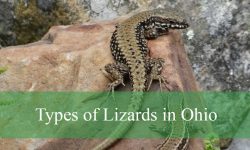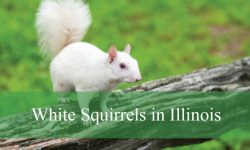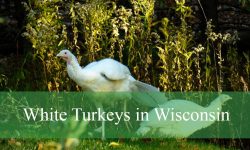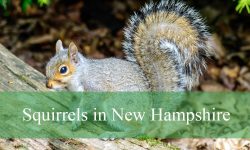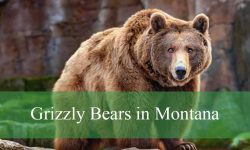Red and yellow flashes of color often reveal one of Kentucky’s most enchanting groups of birds: warblers. These small, energetic songbirds brighten forests, wetlands, and shrubby fields during the spring and fall migrations, delighting birdwatchers with their vibrant plumage and lively behaviors. Despite their size, warblers can be surprisingly vocal, with each species singing distinctive songs that echo through Kentucky’s diverse habitats.
Kentucky is a critical stopover for many migratory warblers traveling between their northern breeding grounds and southern wintering areas. Some species breed within the state, favoring mature hardwood forests, river valleys, and shrublands, while others are fleeting visitors, seen only during migration. Their variety in appearance, song, and habitat preference makes Kentucky an exciting location for bird enthusiasts to explore these avian gems.
Identifying warblers can be a challenge due to their small size and fast movements, but careful observation of plumage patterns, foraging behavior, and song can reveal their species. This guide presents 40 types of warblers found in Kentucky, complete with detailed descriptions, identification tips, and information on their habitats, behaviors, and seasonal presence, helping both novice and experienced birders appreciate these colorful visitors.
Common Warblers Found in Kentucky
Yellow-rumped Warbler
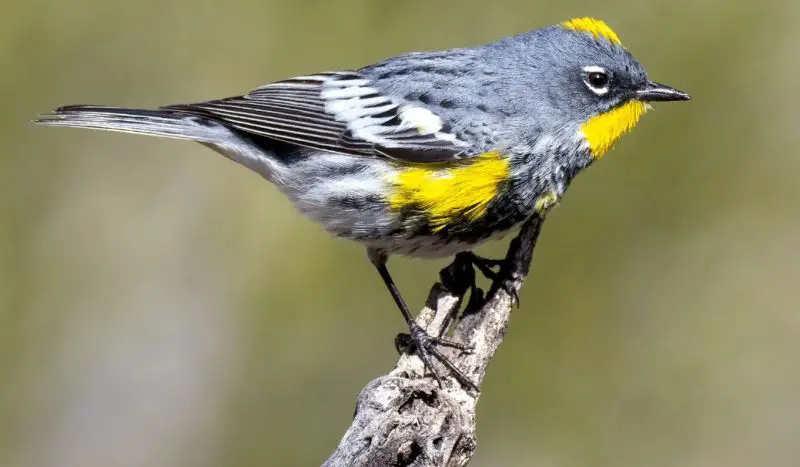
The Yellow-rumped Warbler is one of the most common and widespread warblers in Kentucky, easily recognized by its distinctive bright yellow rump patch, which is visible even in flight. Males in breeding plumage display gray bodies with black streaks and flashes of yellow on the crown and flanks, while females and winter birds appear duller but still retain the characteristic rump marking. Measuring around 5.5 inches in length with a wingspan of up to 9.5 inches, this small bird is both agile and active.
Their behavior is lively, often seen flitting between trees or hovering briefly to pluck insects from foliage. They feed on insects during the warmer months but switch to berries, especially wax myrtle and bayberry, in colder seasons, which allows them to winter farther north than most warblers. Their song is a soft, loose trill, often heard in open woodlands and forest edges. This adaptability in diet and foraging behavior makes them a common sight throughout the year in Kentucky, particularly during migration.
In Kentucky, the Yellow-rumped Warbler is most abundant during spring and fall migrations, passing through forests, parks, and residential areas. Some remain in the state during winter, especially where food sources are available. They prefer mixed woodlands, conifer stands, and shrubby habitats, where they can forage efficiently. Their wide distribution and flexible diet have made them one of the most successful warbler species in North America.
Yellow Warbler
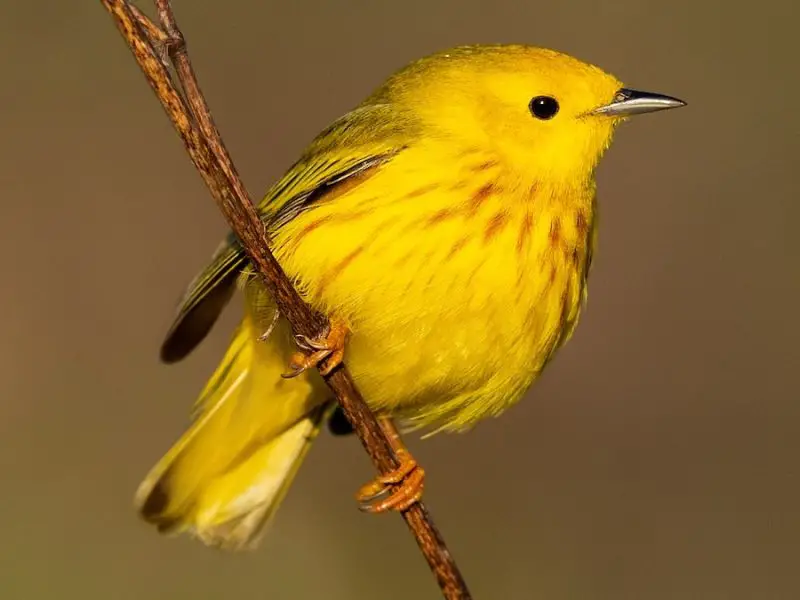
The Yellow Warbler is a bright and easily recognizable species in Kentucky, with males showcasing rich yellow plumage accented by reddish streaks on the breast. Females and immatures are slightly duller but still maintain their vibrant golden tones, making them stand out among green foliage. At about 5 inches long with a wingspan of 7 to 8 inches, this bird is small yet striking, often referred to as the most “yellow” of all warblers.
Known for its sweet and cheerful song, often described as “sweet-sweet-sweeter-than-sweet,” the Yellow Warbler is a welcome sound in spring and summer woodlands. It is an insect-eating bird, feeding primarily on caterpillars, beetles, and other small invertebrates. Their behavior includes active foraging among willows, alders, and other shrubby areas, where they glean insects from leaves and branches. They are highly territorial during the breeding season, often aggressively defending their nesting sites.
In Kentucky, the Yellow Warbler is a common summer resident, especially near wetlands, streams, and wooded edges. They prefer habitats with dense shrubs and small trees, where they build their nests concealed among branches. They arrive in the state in April and May and remain through late summer before migrating south to Central and South America. Their presence in riparian habitats makes them an indicator of healthy wetland ecosystems in Kentucky.
Pine Warbler
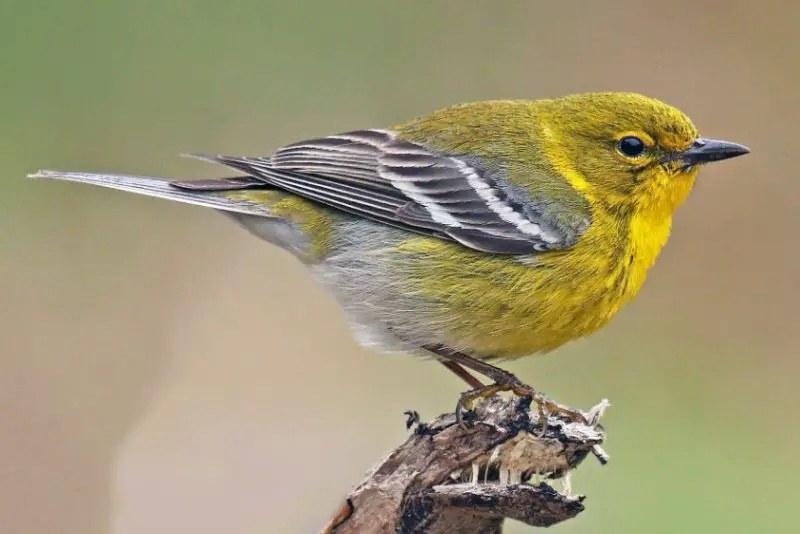
The Pine Warbler is a medium-sized warbler with olive-green upperparts, a yellow throat and breast, and white wing bars. Its appearance is less vivid than some other warblers, but it can be recognized by its subtle beauty and association with pine forests. Adults measure about 5.5 inches long with a wingspan of 8 to 9 inches, while females are slightly duller in color compared to the brighter males.
This species has a distinctive trilling song that resembles that of a Chipping Sparrow but is slower and more musical. True to its name, the Pine Warbler spends much of its time in pine-dominated habitats, where it forages for insects and spiders. Unlike many warblers, it also supplements its diet with seeds and berries, often visiting feeders during the winter for suet and sunflower seeds. Its behavior is less restless than other warblers, giving observers a better chance to spot it among pine branches.
In Kentucky, Pine Warblers are primarily associated with pine stands in the eastern and southern parts of the state. They are year-round residents in some areas, especially where mature pine forests are present, but their numbers increase during migration. Their strong association with pine ecosystems makes them a reliable indicator of healthy conifer habitats within Kentucky’s landscape.
Palm Warbler
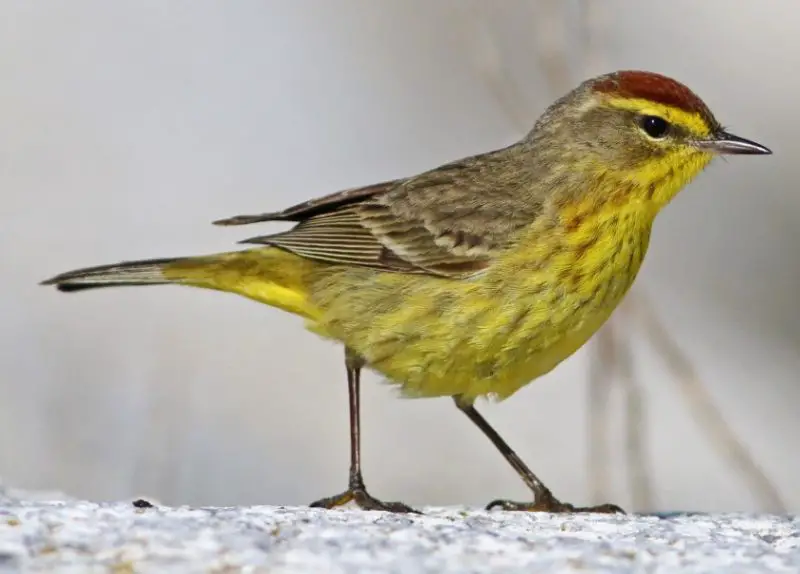
The Palm Warbler is a small but easily identified warbler, known for its constant tail-wagging behavior. It has olive-brown upperparts and a yellowish underside, with breeding males showing a rusty cap and brighter yellow underparts. Measuring about 5 inches in length with a wingspan close to 8 inches, this warbler is slender and active, often seen foraging on the ground.
Its behavior is distinct from many warblers, as it spends more time on the ground in open areas, bobbing its tail up and down while searching for insects. The Palm Warbler’s song is a simple, buzzy trill, less musical than that of many other warblers. During migration, it frequently forages in weedy fields, shrubby edges, and open woodlands, making it more visible to birdwatchers than canopy-dwelling species.
In Kentucky, Palm Warblers are primarily seen during spring and fall migration. They do not breed in the state but pass through in significant numbers, especially in April and September. Their preferred stopover habitats include grassy fields, shrubby edges, and even residential areas with open lawns and scattered trees. Their ground-foraging habits and tail-wagging make them one of the easier warblers to identify during migration in Kentucky.
Prairie Warbler
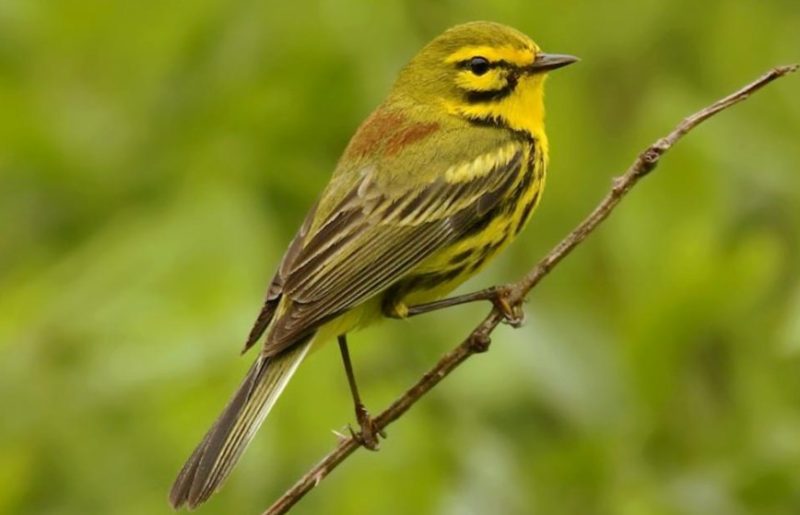
The Prairie Warbler is a small, brightly patterned warbler with olive-green upperparts, a yellow face and underparts, and distinctive black streaks on its sides. Males are more boldly marked than females, with some showing chestnut patches on the back. At about 4.75 inches long with a wingspan of 7 inches, this warbler is among the smaller members of its family.
Its song is a rising series of buzzy notes, often described as sounding like a bouncing ball. The Prairie Warbler is highly active, often flicking its tail and moving rapidly through shrubs and young trees as it searches for insects. Unlike some warblers that prefer tall mature forests, this species thrives in open, shrubby habitats, including regenerating clearings, scrublands, and young pine plantations.
In Kentucky, the Prairie Warbler is a common breeding bird during spring and summer, especially in the eastern and central parts of the state. It arrives in April and departs by late summer, wintering in the Caribbean and Central America. Their preference for shrubby, early successional habitats makes them an important species in landscapes undergoing natural regeneration or managed forest growth.
Black-and-white Warbler
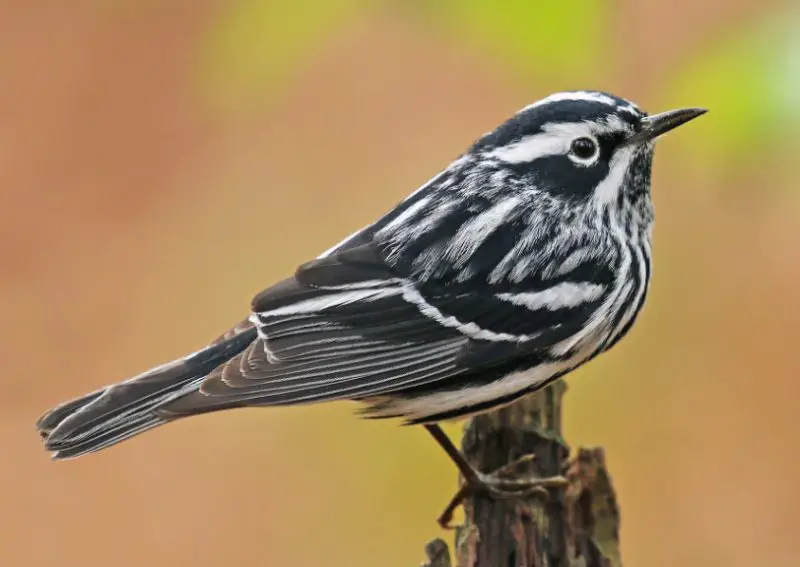
The Black-and-white Warbler is unique among warblers due to its striking zebra-striped plumage. Males and females look similar, with black-and-white streaks across the body, but males tend to have darker throat markings. Measuring about 5 inches in length with a wingspan of 8 to 9 inches, this species is easy to identify by both its plumage and its behavior.
Unlike most warblers that forage among leaves, the Black-and-white Warbler creeps along tree trunks and branches in a manner similar to a nuthatch. It feeds on insects hidden in bark crevices, using its slightly curved bill to probe for prey. Its song is a thin, high-pitched series of notes that resembles a squeaky wheel, often heard in forests during the breeding season.
In Kentucky, the Black-and-white Warbler is a common migrant and summer breeder. It prefers mature deciduous and mixed forests, where it nests on the ground, often hidden among leaves or at the base of a tree. They arrive in April and remain through the summer, before migrating south to Central and South America. Their distinctive foraging style and striking plumage make them one of the more memorable warblers found in Kentucky.
Prothonotary Warbler

The Prothonotary Warbler is a striking species with golden-yellow plumage on the head and breast, contrasting with bluish-gray wings and back. It is one of the few warblers with a solid, unmarked yellow underside, making it relatively easy to identify. Measuring around 5.5 inches in length with a wingspan of 8.5 to 9 inches, this bird is stout and stocky compared to other warblers. Its beauty and unique coloration often make it a favorite among birdwatchers.
Behaviorally, Prothonotary Warblers are cavity nesters, unlike most warblers that build open cup nests. They often use old woodpecker holes or artificial nest boxes in swampy areas. Their song is a series of loud, ringing “sweet-sweet-sweet-sweet” notes that echo through their wetland habitats. They forage actively among branches and low shrubs, searching for insects, spiders, and small snails.
In Kentucky, this warbler is found mostly in swampy forests, wooded floodplains, and areas along rivers. They arrive in late April and stay through the summer, breeding in forested wetlands before migrating to Central America and northern South America for winter. Their reliance on wetland habitats makes them a key indicator species for the health of Kentucky’s riparian ecosystems.
Hooded Warbler
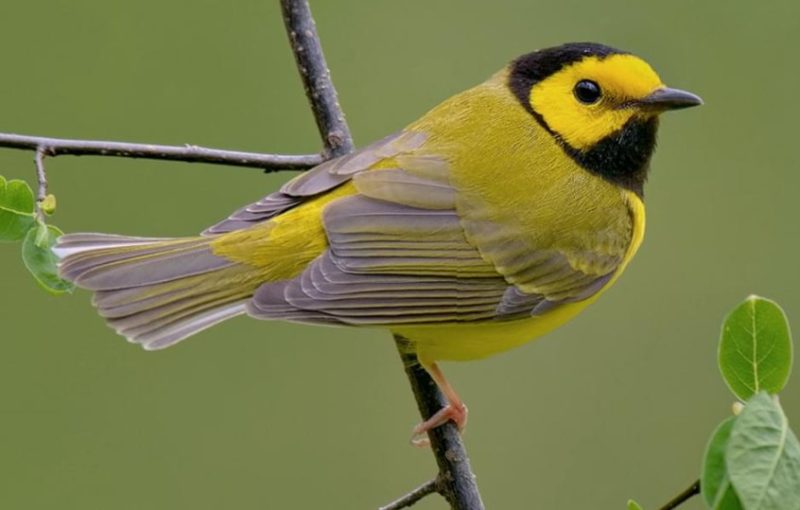
The Hooded Warbler is one of the most distinctive warblers in Kentucky, known for its bold plumage and striking facial pattern. Males have bright yellow faces surrounded by a black hood and throat, while females and immature birds are mostly yellow with olive backs and lack the full hood. At about 5 inches in length with a wingspan of 7 inches, they are small but eye-catching in forest understories.
Their song is a clear and ringing “ta-wit, ta-wit, ta-wee-tee-o,” often delivered from hidden perches in dense foliage. They are active foragers, flitting low in shrubs and saplings as they hunt for insects and spiders. Hooded Warblers are also known for their flicking tail movements, which reveal white tail feathers that flash as they move through the understory.
In Kentucky, Hooded Warblers are summer residents, preferring mature deciduous forests with dense understory vegetation. They are especially common in the central and eastern regions of the state. They arrive in April and remain through late summer before migrating to Central America and the Caribbean. Their strong preference for shaded woodland interiors makes them a reliable sight in Kentucky’s forested landscapes.
Kentucky Warbler

The Kentucky Warbler is a secretive ground-dwelling bird, known for its bright yellow underparts and olive-green back. It has a distinctive black mask and sideburns on its face, giving it a unique and bold appearance. At about 5.5 inches in length with a wingspan close to 8.5 inches, it is robust compared to many other warblers. Despite its name, it is often hard to see in the dense forests of Kentucky.
Its song is a loud, rolling series of notes, often described as “churree-churree-churree,” which carries well through the forest. The Kentucky Warbler spends much of its time foraging on or near the ground, searching for insects, spiders, and other invertebrates among the leaf litter. Their elusive nature makes them more often heard than seen, as they prefer shaded understories and thickets.
In Kentucky, this species is a common breeder in mature deciduous forests with dense understory growth. They arrive in late April and remain through the breeding season, departing in late summer for their wintering grounds in Central America. Their presence in forest habitats highlights the importance of maintaining thick understory vegetation for bird diversity in Kentucky.
Worm-eating Warbler

The Worm-eating Warbler is a subtle but distinctive species, recognized by its buffy-brown plumage and bold black-and-tan head stripes. It lacks the bright colors of many other warblers, but its unique head pattern makes it easy to identify. At around 5.25 inches in length with a wingspan of about 8.5 inches, it is a medium-sized warbler with a slender body and sharp bill.
Unlike its name suggests, this species does not specialize in eating worms. Instead, it feeds on insects and caterpillars, often gleaned from dead leaves. Its song is a dry, rapid trill, somewhat similar to that of a Chipping Sparrow but usually delivered from forested slopes. It spends much of its time skulking in understory and mid-level foliage, making it a challenge to observe.
In Kentucky, the Worm-eating Warbler is a summer breeder, especially in the forested hills of the eastern part of the state. They prefer mature deciduous forests with steep slopes and dense understories. They arrive in late April and remain through summer before migrating to Central America and the Caribbean. Their association with steep, wooded terrain makes them a specialty bird of Kentucky’s Appalachian forests.
Ovenbird
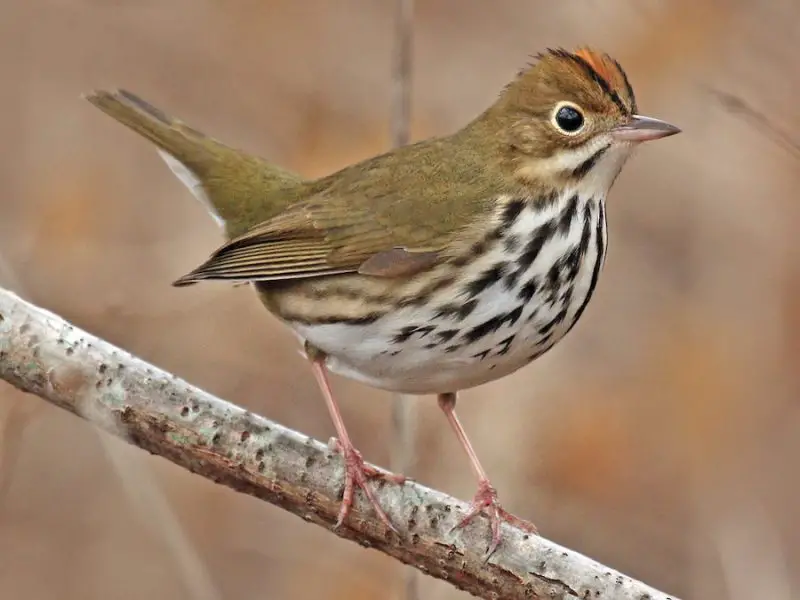
The Ovenbird is a ground-dwelling warbler, named for its distinctive dome-shaped nest that resembles an old-fashioned outdoor oven. It has olive-brown upperparts, a white breast streaked with black, and a bold orange crown bordered by black stripes. At about 6 inches in length with a wingspan of 9 to 10 inches, it is one of the larger warblers and resembles a small thrush in appearance and behavior.
Its loud, ringing song, “teacher-teacher-teacher,” is one of the most easily recognized bird calls in eastern forests. Ovenbirds spend much of their time walking along the forest floor, flipping leaves in search of insects and other small invertebrates. Their behavior is more terrestrial than many other warblers, and they are often seen moving steadily through dense forest understory.
In Kentucky, the Ovenbird is a common breeding bird of mature deciduous forests. They arrive in April and remain through the summer, nesting on the ground in carefully constructed dome-shaped nests. By late summer they depart for Central America, South America, and the Caribbean. Their preference for deep forest interiors makes them an important part of Kentucky’s woodland bird community.
Northern Waterthrush

The Northern Waterthrush is a large, thrush-like warbler with brown upperparts and heavily streaked underparts. It has a pale eyebrow stripe, which helps distinguish it from its close relative, the Louisiana Waterthrush. At about 6 inches in length with a wingspan of 9 inches, it is one of the sturdier and more robust warblers.
This species is usually found near water, where it constantly bobs its tail while foraging along stream banks and wetlands. Its song is a series of loud, emphatic warbling notes, while its call is a sharp “spwik.” The Northern Waterthrush feeds on insects, aquatic invertebrates, and occasionally small fish, often wading at the edges of ponds and creeks.
In Kentucky, Northern Waterthrushes are seen primarily during migration in spring and fall, stopping in wet woodlands, marshes, and along rivers. They do not typically breed in the state but pass through in April and May, and again in late August through September. Their association with watery habitats makes them a distinctive and fairly easy species to locate during migration in Kentucky.
Louisiana Waterthrush
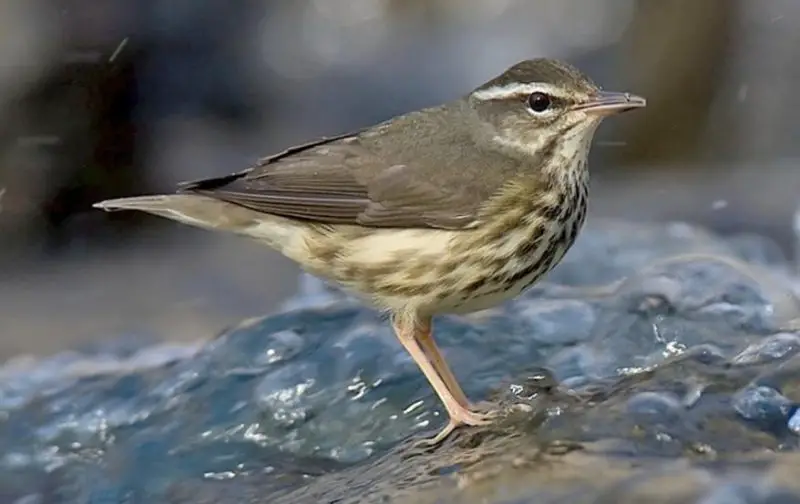
The Louisiana Waterthrush is a large, thrush-like warbler with brown upperparts, a bold white eyebrow stripe, and lightly streaked underparts. It is slightly larger and stockier than most warblers, measuring about 6 inches in length with a wingspan of 9 to 10 inches. Its plumage is more muted than many warblers, but its preference for streamside habitats makes it distinctive.
Its song is a loud, ringing series of notes, usually starting with clear whistles followed by a jumble of trills and warbles. This powerful song carries far in the forest and is one of the earliest signs of spring in Kentucky woodlands. Behaviorally, the Louisiana Waterthrush is almost always found near running water, where it forages along the ground, bobbing its tail while searching for insects, spiders, and aquatic invertebrates.
In Kentucky, this species is a common breeding bird along clear streams in deciduous forests. It arrives as early as March and establishes territories along wooded creeks and rivers. They remain in the state through the summer before migrating to Central America and the Caribbean. Their presence is a strong indicator of clean, healthy waterways in Kentucky’s forests.
Blue-winged Warbler
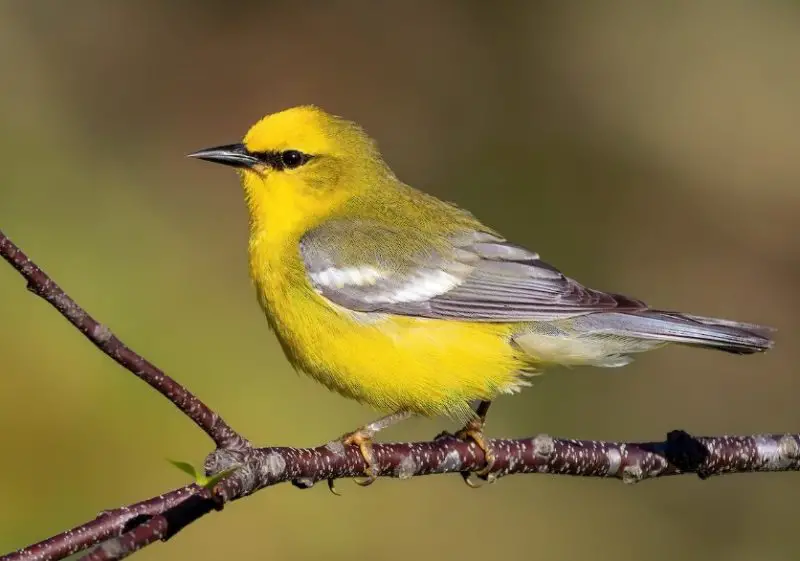
The Blue-winged Warbler is a small and brightly colored species, with a lemon-yellow body, contrasting bluish-gray wings, and bold black line through the eye. Measuring around 4.75 inches in length with a wingspan of 7 inches, it is a slender bird often spotted flitting among shrubby thickets. Its appearance is simple yet striking, making it relatively easy to identify.
Its song is a distinctive, buzzy “bee-buzz,” which is short but easily recognized. This warbler spends much of its time low in shrubs, foraging for caterpillars, beetles, and other insects. It often flicks its wings and tail as it moves through vegetation. Blue-winged Warblers are known for hybridizing with Golden-winged Warblers, producing “Brewster’s” and “Lawrence’s” Warblers, which adds to their identification interest.
In Kentucky, the Blue-winged Warbler breeds in shrubby fields, regenerating clearings, and forest edges, particularly in the central and northern regions. They arrive in April and remain through the summer before migrating to Central America. Their reliance on shrubby habitats makes them more common in areas of young or regenerating growth rather than mature forests.
Golden-winged Warbler
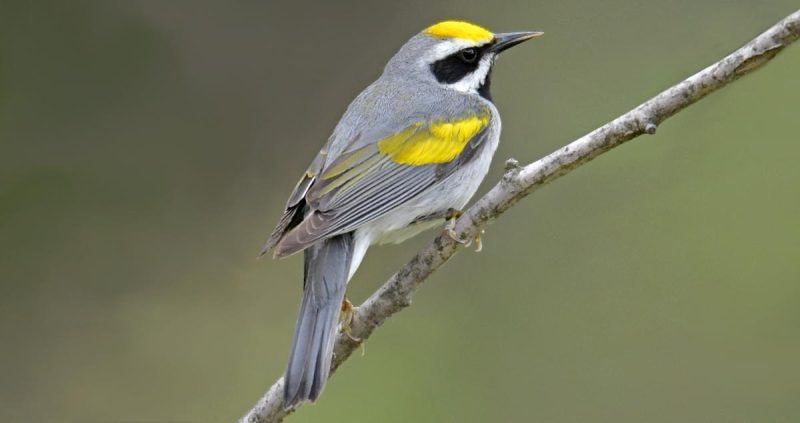
The Golden-winged Warbler is a striking species with a gray body, white underparts, black throat and face mask, and bright yellow patches on the crown and wings. Slightly larger than the Blue-winged Warbler, it measures about 5 inches in length with a wingspan of 7.5 to 8 inches. Its bold markings make it one of the most distinctive warblers in North America.
Its song is a simple, buzzy “zee-zee-zee,” softer than that of the Blue-winged Warbler but easily recognized once learned. The Golden-winged Warbler forages actively in shrubs and low branches, feeding on insects, spiders, and larvae. Unfortunately, this species has declined significantly due to habitat loss and hybridization with Blue-winged Warblers.
In Kentucky, Golden-winged Warblers are rare and mostly observed during migration in spring and fall. They pass through shrubby habitats, forest edges, and young woodlands, particularly in the eastern part of the state. Although they historically bred in parts of Kentucky, their nesting population has nearly disappeared, making migration periods the best chance to see them.
Tennessee Warbler
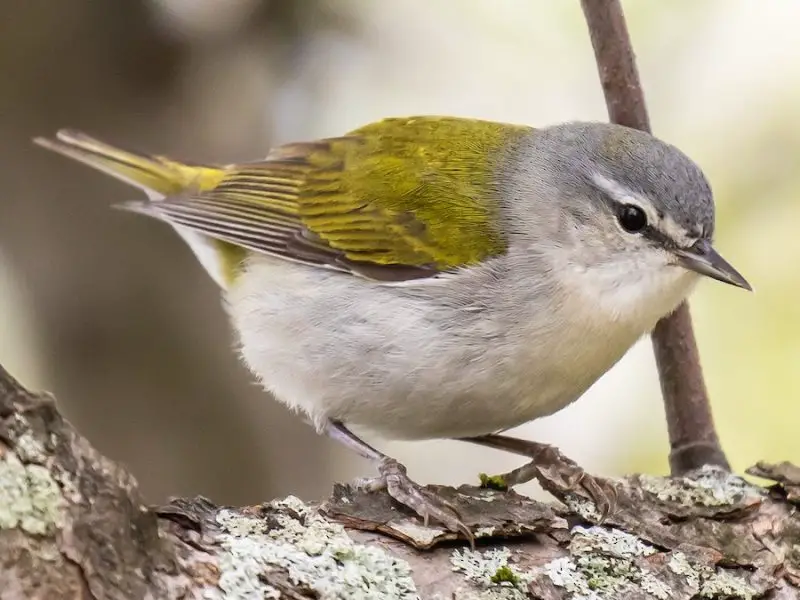
The Tennessee Warbler is a small, slender warbler with gray-green upperparts, a whitish underside, and a thin sharp bill. It lacks bold markings, but its plain appearance can be recognized by its clean face with a faint eyebrow. Measuring about 4.75 inches in length with a wingspan of 7.5 inches, it is one of the smaller warblers found in Kentucky.
Its song is a rapid series of high-pitched notes and trills, often described as insect-like. Tennessee Warblers are highly active foragers, moving quickly through trees and shrubs as they search for caterpillars, especially those feeding on spruce budworms. Their energetic movements and constant calling make them more noticeable during migration despite their plain coloration.
In Kentucky, Tennessee Warblers are abundant during spring and fall migrations. They pass through woodlands, parks, and even backyards, often traveling in mixed flocks with other migrant warblers. They do not breed in Kentucky, instead nesting in Canada’s boreal forests, but their migration through the state is a highlight for birdwatchers each spring and autumn.
Orange-crowned Warbler
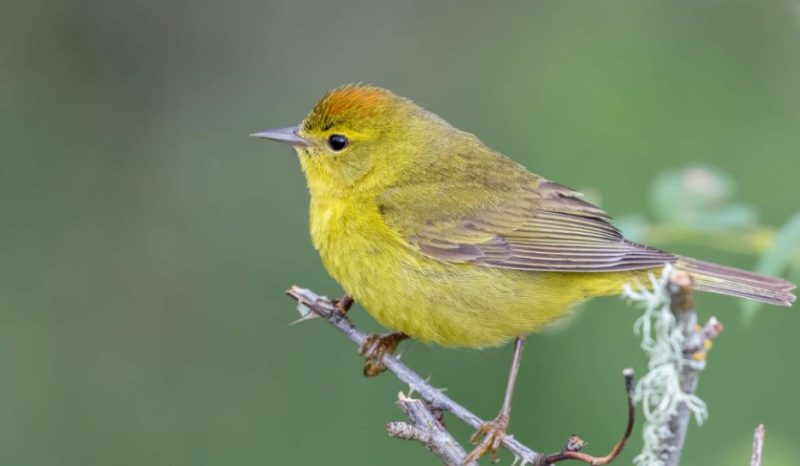
The Orange-crowned Warbler is a subtle species with olive-green plumage, faint streaking on the breast, and a thin, sharp bill. Its namesake orange crown is usually hidden and only occasionally visible when the feathers are raised. Measuring about 5 inches in length with a wingspan of 7.5 inches, it is a small and inconspicuous warbler.
Its song is a simple, descending trill, less musical than many other warblers. Orange-crowned Warblers forage actively in shrubs and trees, searching for insects, spiders, and occasionally berries. They are often seen creeping through foliage in a manner similar to a vireo, and their plain appearance can make them difficult to spot.
In Kentucky, Orange-crowned Warblers are mostly seen during migration in spring and fall. They pass through forests, shrubby fields, and residential areas, with some individuals lingering into late fall. They do not breed in the state but instead nest in northern Canada and Alaska, wintering in the southern United States, Mexico, and Central America.
Nashville Warbler
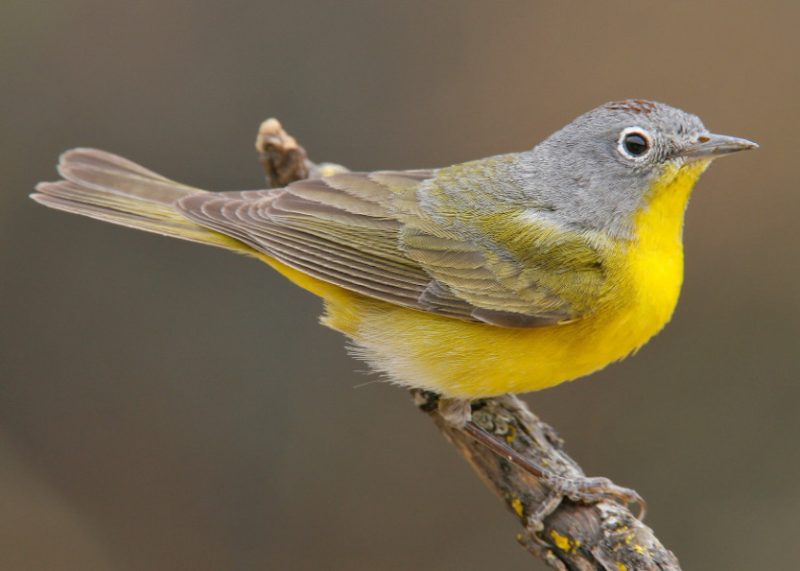
The Nashville Warbler is a small and colorful species, with olive-green upperparts, a bright yellow throat and belly, and a gray head with a thin white eye-ring. Adults sometimes show a rusty crown patch, though it is usually hidden. At about 4.75 inches long with a wingspan of 7 to 8 inches, it is a dainty and attractive bird.
Its song is a two-part phrase, beginning with a series of clear notes followed by a faster trill, often repeated persistently from treetops. Nashville Warblers forage for insects and caterpillars among shrubs and trees, often hanging upside down to glean prey from leaves. Their energetic movements make them a lively presence during migration.
In Kentucky, Nashville Warblers are primarily migrants, passing through in spring and fall. They can be found in woodlands, brushy areas, and even gardens during migration periods. They breed farther north in Canada and the northern United States, but their stopovers in Kentucky provide birdwatchers with an opportunity to enjoy their bright colors and cheerful songs.
Mourning Warbler
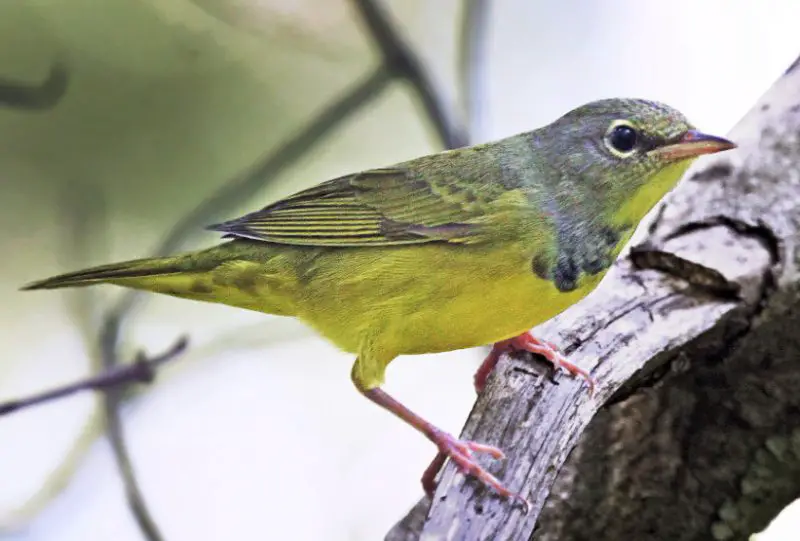
The Mourning Warbler is a medium-sized songbird recognized by its olive-green back, yellow underparts, and gray hood that contrasts with its darker face. Adult males display a distinctive black patch on their breast, while females and juveniles are more muted in color. They measure about 5 to 6 inches in length with a wingspan of 8 to 9 inches, making them a bit stockier compared to some other warbler species.
This secretive bird prefers dense, shrubby habitats where it can stay hidden while foraging close to the ground. Mourning Warblers are often heard before they are seen, with a distinctive, rolling song that rises and falls in pitch. They are active foragers, moving low among thick vegetation in search of insects, spiders, and caterpillars. Their behavior makes them challenging to spot despite their bright coloring.
In Kentucky, Mourning Warblers are primarily seen during migration in spring and fall, passing through wooded edges, overgrown fields, and regenerating forests. They breed farther north, in the Great Lakes region and into Canada, but their migration route brings them consistently through the state. Birdwatchers in Kentucky often rely on their unique song to detect their presence.
Connecticut Warbler
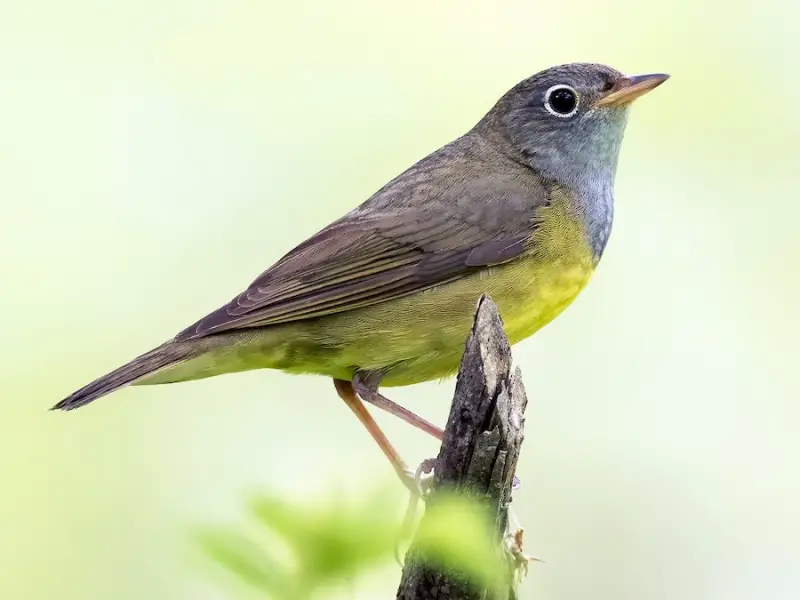
The Connecticut Warbler is a rare and elusive bird with an olive-green back, yellow belly, and a gray hood that covers the head and throat. Males and females look similar, though males may show a slightly richer hood color. Measuring about 5.5 to 6 inches long, they have a relatively large eye ring that gives them a wide-eyed expression, which is one of their best identification features.
This warbler is shy and often stays low in dense thickets, making it difficult to observe. Its song is loud and ringing, consisting of repeated phrases that carry well through its preferred habitat. It forages mainly on the ground, feeding on beetles, caterpillars, and other insects, probing through leaf litter as it moves deliberately and slowly compared to more active warblers.
In Kentucky, the Connecticut Warbler is an uncommon migrant, seen only during spring and fall migration. They prefer damp, wooded areas, thickets, and brushy fields where they can remain hidden. Because of their scarcity and secretive habits, spotting one in Kentucky is considered a special event for birders.
Common Yellowthroat
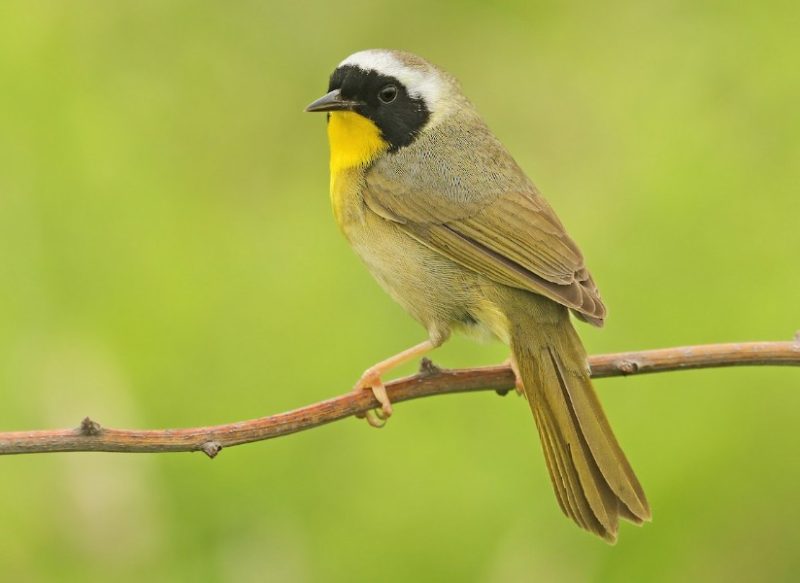
The Common Yellowthroat is one of the most recognizable warblers, especially the males with their bright yellow throats and breasts paired with a bold black mask across the face. Females and juveniles lack the black mask, appearing more subdued with olive backs and pale underparts. They are small birds, around 4 to 5 inches in length with rounded wings and a sharp, active demeanor.
These warblers are known for their distinctive “witchety-witchety-witchety” song, which is frequently heard in wetlands and shrubby areas. They forage low to the ground, flitting through thick vegetation in search of insects, beetles, and spiders. Their active movements and constant tail flicking make them easier to observe compared to more secretive species.
In Kentucky, Common Yellowthroats are abundant during the breeding season, thriving in marshes, wet meadows, and brushy fields. They can also be found during migration in similar habitats throughout the state. Their adaptability to different shrubby environments makes them one of the most widespread warblers in Kentucky.
Wilson’s Warbler
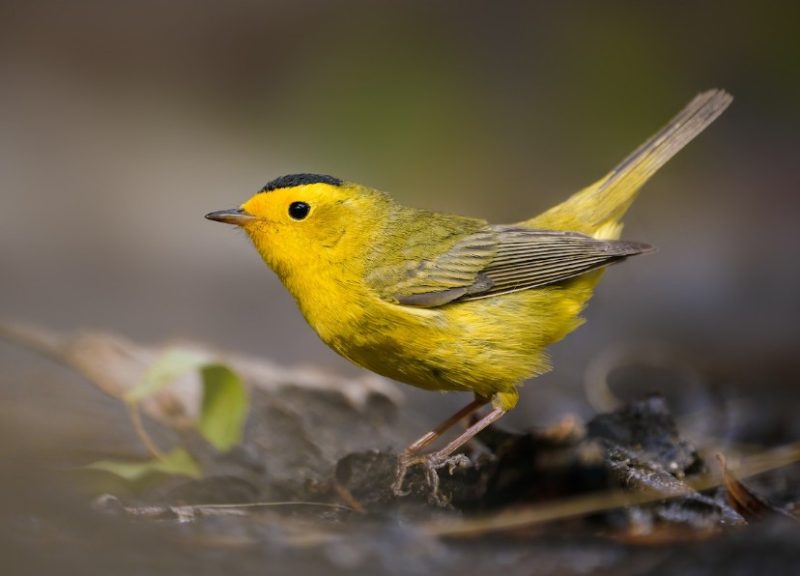
Wilson’s Warbler is a small, lively bird easily recognized by its bright yellow plumage and distinct black cap on the male’s head. Females may show a faint or incomplete cap, but both sexes share the same vibrant yellow face and body contrasted with olive-green upperparts. They are one of the smaller warblers, typically measuring about 4.5 inches long with a wingspan under 7 inches.
Their behavior is highly energetic, with quick movements as they forage for insects among shrubs and low branches. Wilson’s Warblers are not shy and can often be observed actively flitting about in plain view. Their song is a rapid, chattering series of notes that differs from the rolling phrases of other warblers, making it a useful identification clue.
In Kentucky, Wilson’s Warblers appear mostly during migration in spring and fall, moving through forests, shrubby areas, and along streams. They do not breed in the state but are common passage migrants. Observers often encounter them in mixed flocks of migrating warblers as they move toward or away from their northern breeding grounds.
Canada Warbler
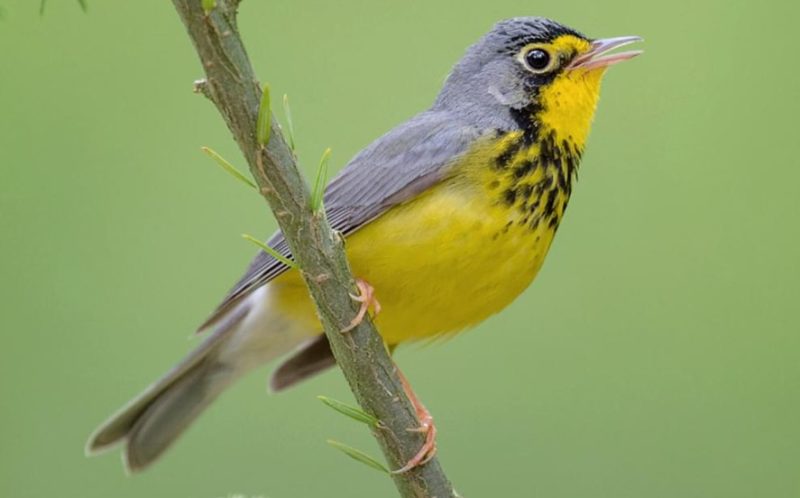
The Canada Warbler is a striking species with a slate-gray back, yellow underparts, and a bold black necklace of streaks across its chest. Its large, expressive white eye ring gives it a bright-eyed look. Measuring about 5 to 6 inches in length, this bird is among the most distinctive and beautiful warblers to pass through Kentucky.
Active and agile, Canada Warblers forage for insects by hopping quickly among low shrubs and saplings. Their behavior is lively but not as frenetic as some other warblers, and their clear, musical song consists of short, tumbling notes. They often sing from concealed perches within dense vegetation, making them easier to hear than to see.
In Kentucky, Canada Warblers are seen mainly during migration, as they breed farther north in boreal forests and spend winters in South America. They favor dense understory habitats during their stopovers, such as young forests, stream edges, and thickets. Birders in Kentucky prize sightings of this species due to its beauty and relative scarcity.
American Redstart
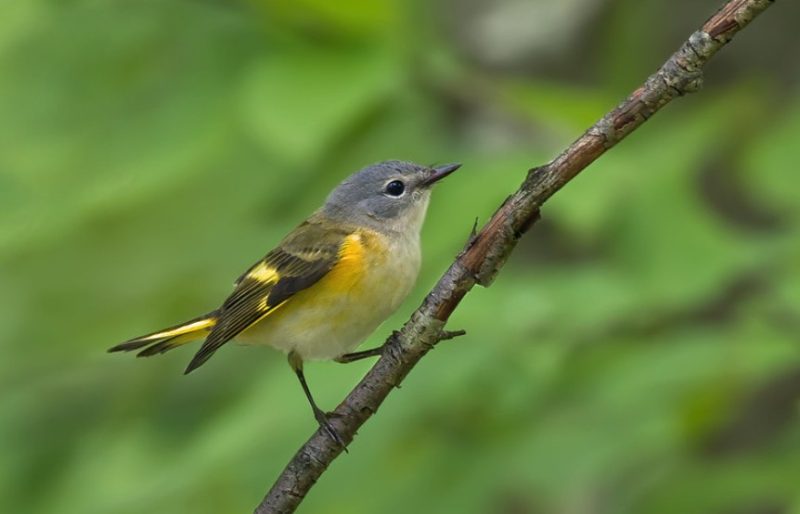
The American Redstart is a vibrant and energetic warbler, with males displaying striking black plumage accented by bright orange patches on the wings, tail, and sides. Females and immature birds are more subdued, with grayish or olive tones highlighted by yellow instead of orange. They measure around 5 to 5.5 inches in length, with a slim build and long tail that they fan frequently while foraging.
This species is especially active, darting and flaring its tail to startle insects, which it then chases down in midair. Its hunting style is more similar to a flycatcher than a typical warbler. The song is a series of high, thin notes that vary between individuals, adding to the challenge of identification by sound alone.
In Kentucky, American Redstarts are regular breeders in deciduous forests, especially near streams and moist woodlands. They are also common migrants during spring and fall. Their active foraging behavior and bold coloration make them one of the easier warblers to spot and enjoy in the state.
Cerulean Warbler
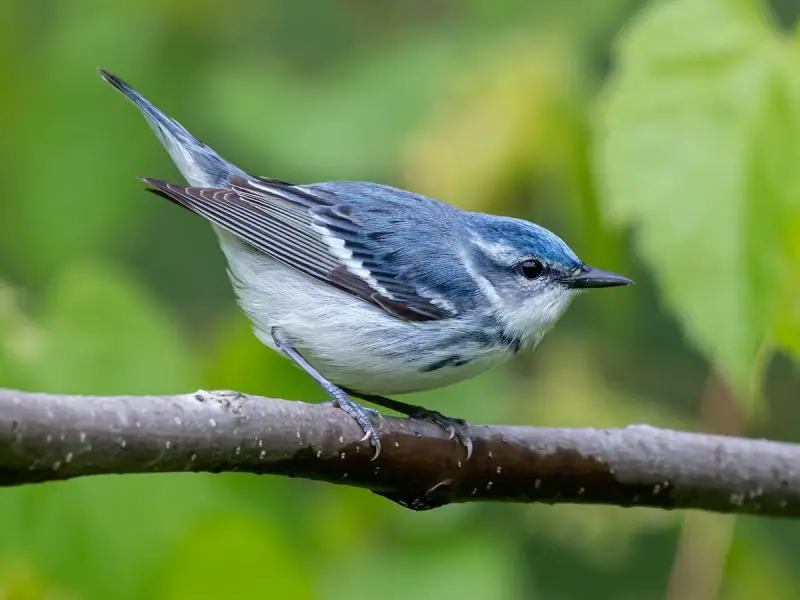
The Cerulean Warbler is a small, sky-blue songbird that is highly sought after by birders due to its beauty and declining population. Males are a brilliant cerulean blue above with a white underside and faint black streaking across the back and sides, while females are more subdued with bluish-green tones and a pale yellowish wash below. Measuring about 4.5 inches long, this species has a short tail and delicate build, making it one of the smaller warblers.
Cerulean Warblers are canopy specialists, spending most of their time high in mature deciduous forests where they forage for insects. Their song is a buzzy, rising series of notes that often helps birders locate them far above in the treetops. They are quick and active, moving rapidly among branches, which makes spotting them a challenge despite their vivid coloring.
In Kentucky, the Cerulean Warbler is a breeding species, particularly in mature hardwood forests of the Appalachian region and along river valleys. The state is an important part of its breeding range, although habitat loss has led to population declines. Kentucky birders cherish the arrival of these striking warblers each spring, when their songs fill the forest canopy.
Magnolia Warbler
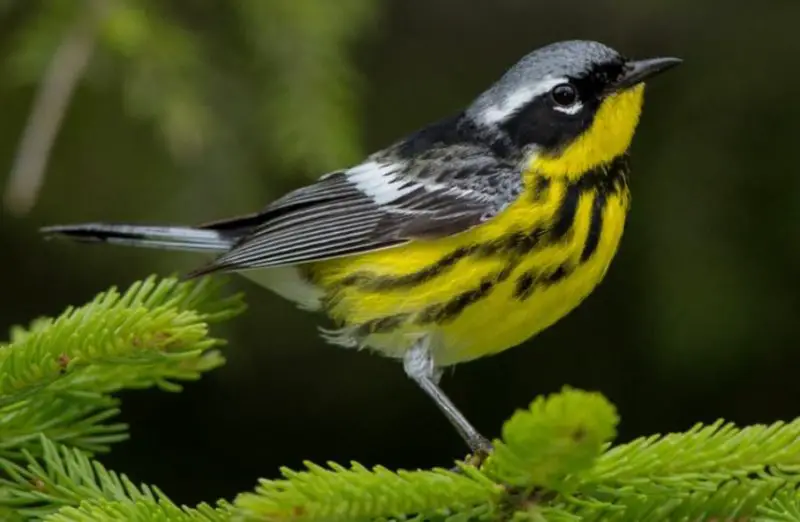
The Magnolia Warbler is a small but brightly patterned bird with striking plumage that makes it easy to recognize. Males in breeding plumage have a black mask, bold black streaks across a yellow breast, and a black back with gray and white highlights. Females and immatures are more subdued, but still show the yellow underparts and distinctive tail pattern with white at the base and tip. They measure about 4.5 to 5 inches in length.
This warbler is known for its energetic foraging behavior, often flitting among low shrubs and trees where it gleans insects from foliage. Unlike some warblers that stick to the canopy, the Magnolia Warbler frequently forages at eye level, giving observers a better chance of seeing its distinctive markings. Its song is a short, clear series of notes that varies slightly across individuals.
In Kentucky, Magnolia Warblers are common migrants during spring and fall. They breed farther north in coniferous forests of Canada and the northern United States but pass through Kentucky in large numbers. During migration, they can be found in woodlands, forest edges, and even suburban areas with sufficient tree cover.
Cape May Warbler
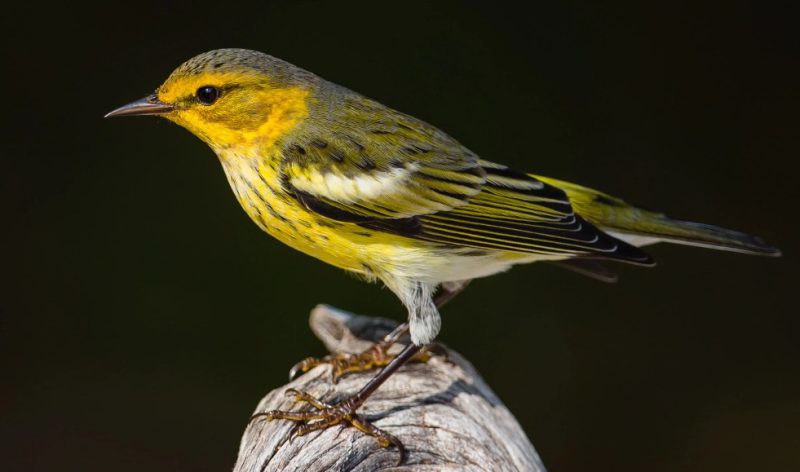
The Cape May Warbler is a small, colorful bird with distinctive markings. Breeding males feature a chestnut-colored cheek patch, yellow underparts with dark streaks, and a bright yellow collar around the neck. Females and immatures are duller but still show streaking on the breast and a somewhat yellow-tinged face. They are about 5 inches long, with a slim build and slightly curved bill.
This species is known for its specialized feeding habits, particularly its ability to feed on nectar using its tubular tongue, in addition to insects. It is especially fond of spruce budworms, which make up a large portion of its diet during the breeding season. Its song is a high-pitched, buzzy series of notes that can be difficult to distinguish from other warblers without experience.
In Kentucky, the Cape May Warbler is primarily a migrant, seen during spring and fall as it moves between its northern breeding grounds in boreal forests and its Caribbean wintering areas. They often appear in coniferous and mixed forests during migration, and their striking plumage makes them a memorable sight for birdwatchers.
Black-throated Blue Warbler
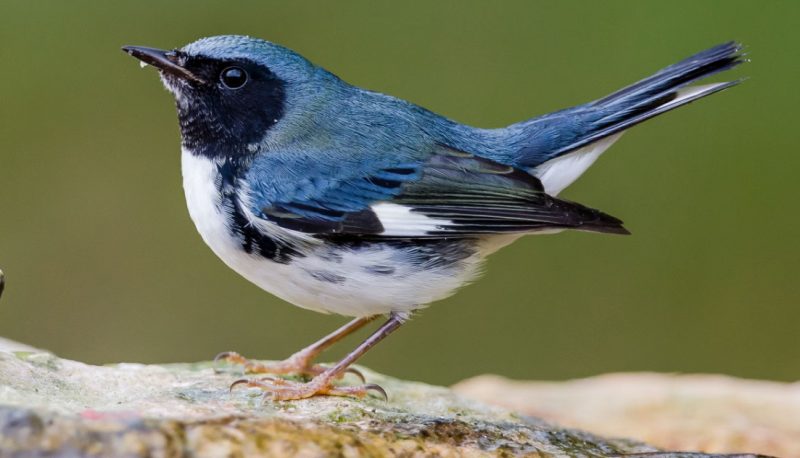
The Black-throated Blue Warbler is a striking and easily recognizable warbler, with males showing deep blue upperparts, a black face and throat, and white underparts accented by a small white wing patch. Females look very different, with olive-brown upperparts and pale yellowish underparts, though they share the white wing patch. Both sexes are about 5 inches in length with a stocky build compared to many other warblers.
This species is deliberate and methodical in its foraging, moving slowly through low and mid-level forest vegetation as it picks insects and spiders from leaves. Its song is a clear, rising series of notes often transcribed as “I’m so la-zy,” which helps distinguish it from other woodland warblers. The contrast between its plumage and measured movements makes it stand out in the forest.
In Kentucky, Black-throated Blue Warblers are mainly seen during migration in both spring and fall. They favor dense understory habitats such as thickets and second-growth forests during stopovers. Although they breed farther north in the Appalachians and northeastern forests, Kentucky provides important migratory habitat for this species.
Black-throated Green Warbler
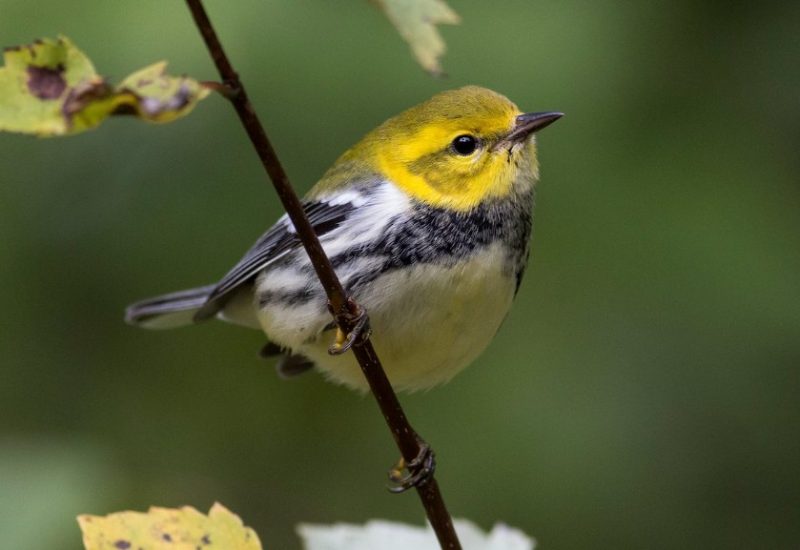
The Black-throated Green Warbler is a small bird with bright yellow cheeks, olive-green back, and black streaking across the breast and throat. Males are especially bold with their black bib and clear contrast between the yellow face and white underparts. Females and immatures are paler but still show the distinctive yellow face. They are about 4.5 to 5 inches long with a sharp, slender bill.
This warbler is known for its persistent and distinctive song, often described as “zee-zee-zee-zoo-zee,” which echoes through forests during the breeding season. It forages actively in coniferous and mixed forests, moving among the branches to glean insects and caterpillars. Its combination of bright coloring and frequent singing makes it easier to detect than some more secretive warblers.
In Kentucky, the Black-throated Green Warbler is found both as a migrant and as a breeder in the eastern part of the state. They prefer mixed woodlands with hemlocks, spruces, and hardwoods, especially in the Appalachian region. Their bright songs and striking plumage make them a favorite among birdwatchers in Kentucky’s forests.
Blackpoll Warbler
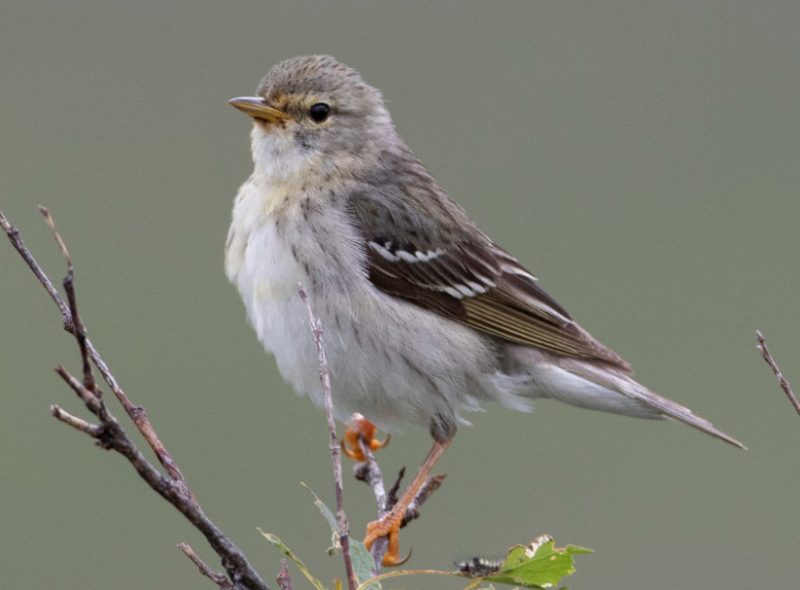
The Blackpoll Warbler is a small but remarkable species, especially known for its long migratory journey. Breeding males have black caps, white cheeks, and streaked black-and-white bodies, while females and immatures are more olive-colored with subtle streaking. They measure about 5.5 inches long, with a slim frame and sharp bill.
Behaviorally, the Blackpoll Warbler is an active forager, moving among trees to catch insects, caterpillars, and spiders. Their song is a high-pitched, rapid series of notes that can be difficult for some people to hear due to its high frequency. Despite their small size, these birds are strong fliers, capable of nonstop flights over the Atlantic Ocean during migration.
In Kentucky, Blackpoll Warblers are seen mainly during spring and fall migration as they travel between their breeding grounds in the boreal forests of Canada and their wintering areas in South America. They can appear in a variety of wooded habitats during their stopovers, including parks and forest edges, giving birders in the state a chance to witness this incredible traveler.
Bay-breasted Warbler
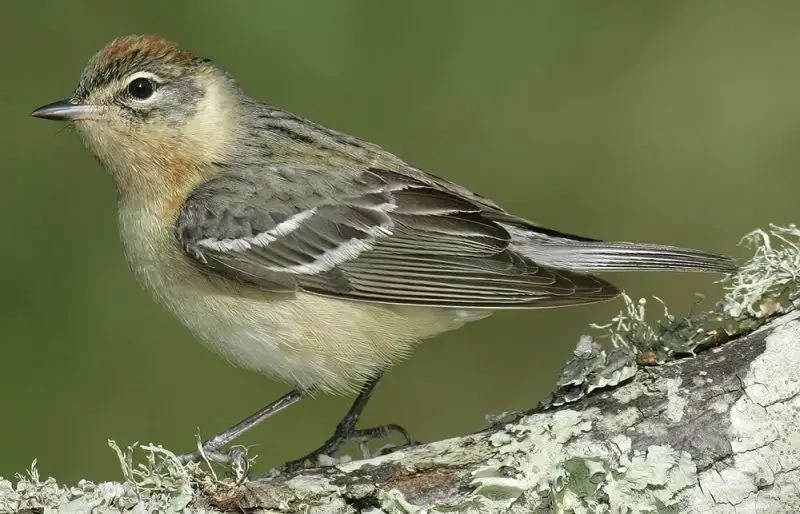
The Bay-breasted Warbler is a striking bird in breeding plumage, with males showing a rich chestnut-colored throat and flanks, contrasted by a black face, gray back, and cream-colored underparts. Females and immatures are duller, often with hints of chestnut and greenish tones, but they still display the characteristic pale wing bars. At about 5.5 inches in length, this species is medium-sized among warblers and has a sturdy, compact build.
Its feeding behavior varies with the season. During the breeding season, it specializes in hunting spruce budworms, moving methodically through coniferous branches to catch its prey. Outside of breeding, it feeds on a variety of insects and berries, often joining mixed flocks. The Bay-breasted Warbler’s song is a soft, high-pitched trill that blends easily into the forest chorus, making it harder to detect by sound alone.
In Kentucky, this species is primarily observed during spring and fall migration, as it travels between its boreal forest breeding grounds in Canada and its wintering range in northern South America. Migrants often appear in woodlands, especially in areas with spruce or mixed forests. Their richly colored plumage makes them a favorite among birders lucky enough to encounter them in the state.
Chestnut-sided Warbler

The Chestnut-sided Warbler is a small, colorful warbler best recognized by the chestnut streaks running down the flanks of breeding males. They also have bright yellow crowns, black-streaked backs, and white underparts. Females and immatures lack the bold chestnut markings but show a clean white underside, yellowish crown, and greenish back. They are about 4.5 to 5 inches long, with a slender frame and sharp bill.
This warbler is active and often sings persistently during the breeding season. Its song is a cheerful series of high-pitched notes often described as “pleased-pleased-pleased-to-MEET-you,” making it one of the easier warblers to identify by sound. Foraging close to the ground and in shrubs, it gleans insects and spiders with quick, darting movements.
In Kentucky, Chestnut-sided Warblers are mainly migrants, passing through during spring and fall. They prefer shrubby habitats, young forests, and regenerating clearings during migration, often staying low where they can be seen at eye level. Although they breed farther north, Kentucky offers excellent stopover sites for this lively and vocal species.
Blackburnian Warbler
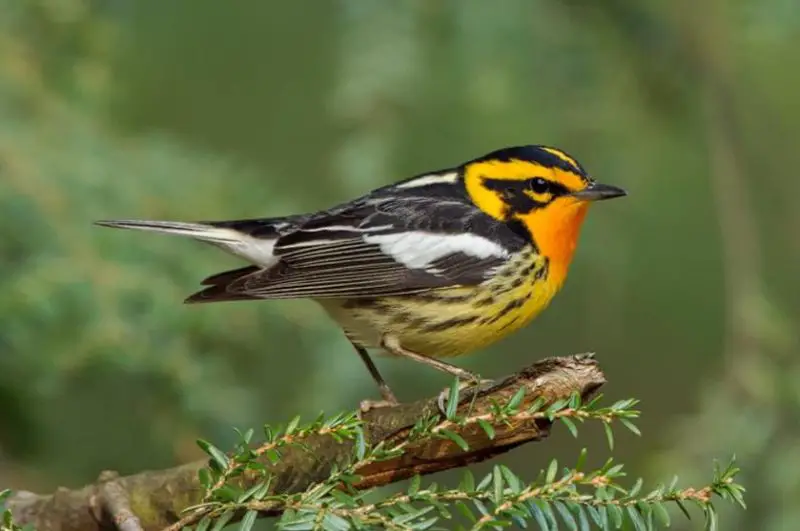
The Blackburnian Warbler is one of the most stunning warblers, known for the fiery orange throat and face of breeding males, which contrasts dramatically with their black crown, dark wings, and white underparts streaked with black. Females and immatures are less vivid but still show yellowish-orange throats and a similar overall pattern. They are about 4.5 to 5 inches long with a slim, agile build.
This species is a canopy dweller, foraging high in tall trees where it hunts insects, particularly caterpillars. Its song is a series of high, thin notes that rise in pitch and end in a sharp, glassy trill. The Blackburnian Warbler is often more easily heard than seen, as its preference for treetop habitats makes observation difficult without patience and good optics.
In Kentucky, Blackburnian Warblers are migrants seen during spring and fall. They breed in northern and high-elevation forests but travel through the state en route to and from their South American wintering grounds. Birders often look for them in forested areas, especially where tall trees provide suitable stopover habitat.
Yellow-throated Warbler
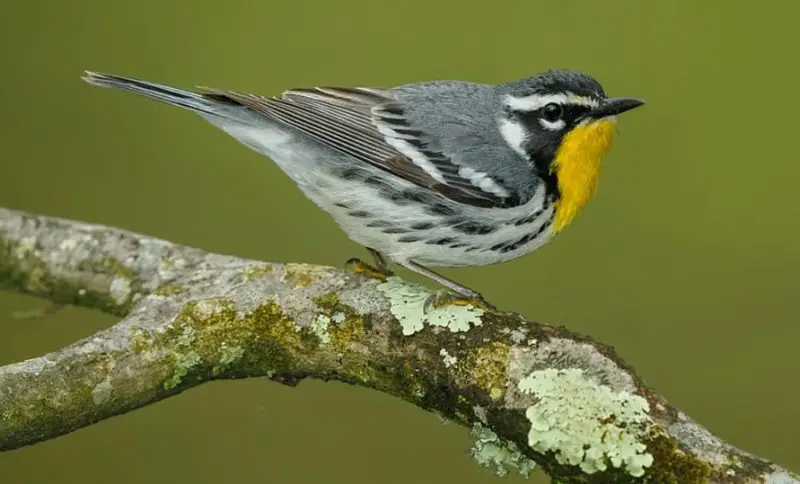
The Yellow-throated Warbler is a sleek and striking species, with a bright yellow throat, white underparts, gray back, and bold black streaking on the face and sides. Its sharp black eye stripe and long, pointed bill give it a distinctive, clean look. At about 5.5 inches in length, this warbler is slightly larger and slimmer than many of its relatives.
It is known for its deliberate foraging style, creeping along branches and probing into crevices for insects and spiders. Its song is a series of sweet, descending whistles that carry well through the trees. Unlike some warblers that stay in dense thickets, the Yellow-throated Warbler often forages in the open, making it easier to observe.
In Kentucky, this species is a regular breeder, favoring mature forests, river valleys, and areas with tall sycamores and pines. They are often seen in the eastern and central parts of the state, where their bright plumage and clear song make them stand out. They remain through the summer before migrating south in the fall.
Northern Parula

The Northern Parula is a small, colorful warbler, measuring just 4.5 inches long, with bluish-gray upperparts, a greenish back patch, and yellow throat and breast accented by a dark chest band. Males are brighter than females, though both sexes share the same general appearance. Their short tails and compact bodies give them a distinctive shape compared to longer-tailed warblers.
This species is highly active, flitting about high in trees as it searches for insects and spiders. Its buzzy, rising trill of a song is one of the most distinctive sounds of spring and summer in its range. Despite their high-canopy habits, Northern Parulas are often vocal and conspicuous, making them easier to locate by ear.
In Kentucky, Northern Parulas are common breeders in moist forests, especially those with Spanish moss or hanging lichens where they build their nests. They are widely distributed across the state during the summer months, particularly along streams and wooded areas, before migrating south in the fall.
Swainson’s Warbler
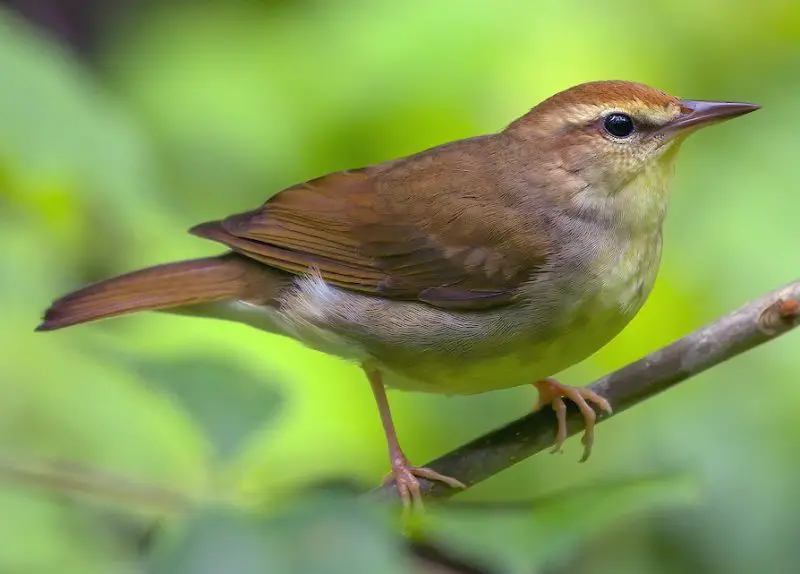
Swainson’s Warbler is a secretive and plain-colored bird, with olive-brown upperparts, pale underparts, and a slightly reddish crown. Its long, pointed bill and bold eyebrow stripe are key identification features. At about 5.5 inches in length, it is a medium-sized warbler with a somewhat heavy appearance compared to its more brightly colored relatives.
This warbler is known for its elusive behavior, spending much of its time in dense understory vegetation where it forages on or near the ground. It probes through leaf litter and low plants for insects, beetles, and spiders. Its loud, ringing song is often the best clue to its presence, carrying through thick vegetation even when the bird itself remains hidden.
In Kentucky, Swainson’s Warblers are rare but regular breeders, primarily in the southeastern part of the state in swampy forests, canebrakes, and rhododendron thickets. Their secretive nature makes them difficult to spot, and many birders rely on hearing their distinctive song to confirm their presence. For those fortunate enough to see one, it is considered a special highlight of birding in the region.
Kirtland’s Warbler
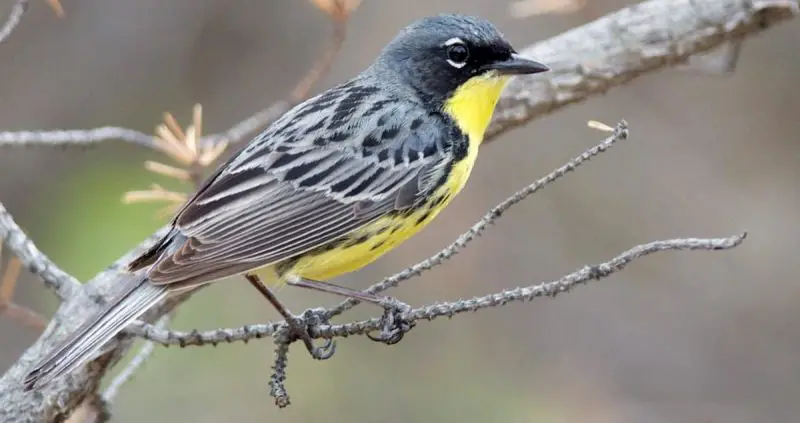
The Kirtland’s Warbler is a rare and highly sought-after species, with males exhibiting gray upperparts, a bright yellow breast, and black streaking along the flanks. Females are duller, with paler yellow underparts and more subdued gray upperparts. This medium-sized warbler measures about 5 to 5.5 inches in length and has a slender, compact build, making it distinguishable from more common warblers.
Behaviorally, Kirtland’s Warblers are shy and secretive, often staying low in dense scrub or young jack pine stands in their breeding range. Their song is a high, dry trill that carries through the undergrowth but is less musical than that of many other warblers. They forage actively for insects and spiders among low shrubs and ground litter, rarely venturing into open areas.
In Kentucky, the Kirtland’s Warbler is an extremely rare migrant, appearing only occasionally during spring or fall. Observers must be vigilant in shrubby fields or regenerating forests to spot this species, as it is primarily a breeder in Michigan’s jack pine forests. Any sighting in the state is considered a notable event among birders.
Townsend’s Warbler
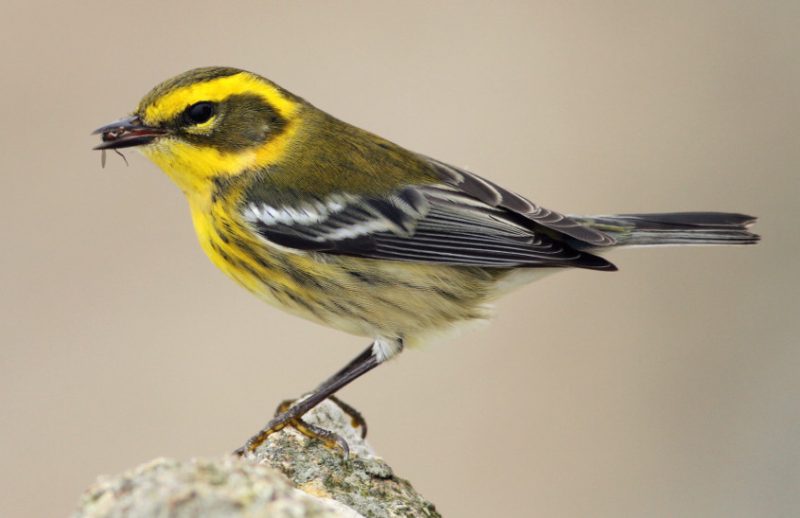
Townsend’s Warbler is a rare vagrant in Kentucky, typically recognized by its striking black-and-yellow facial pattern, olive-green back, and yellow underparts with faint streaking. Adult males have bolder black markings on the throat and sides of the face, while females and immatures are more muted but maintain the yellow and olive coloration. They measure about 5 inches in length and have a slender, agile build.
This species forages actively among tree branches, especially in coniferous trees, gleaning insects and spiders from needles and bark. Its song is a high-pitched, rapid series of notes, sometimes described as “tsi-tse-tse-tse,” which may be difficult to distinguish from other warblers unless observed closely. Townsend’s Warblers are often seen alone or in small mixed flocks during migration.
In Kentucky, Townsend’s Warblers are extremely rare and mostly appear as accidental or vagrant individuals during migration periods. Sightings are typically in forested areas with conifers or mixed woodlands. Because of their rarity, any appearance in the state draws attention from local and visiting birders.
Black-throated Gray Warbler
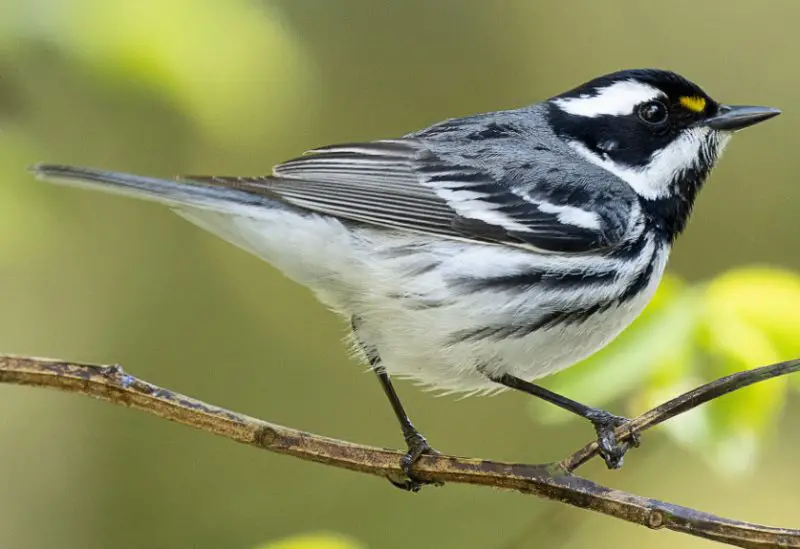
The Black-throated Gray Warbler is a striking yet very rare vagrant in Kentucky, easily recognized by its gray upperparts, white underparts, bold black throat, and distinctive white wing bars. Males have a sharply contrasting black face and throat, while females and immatures are more subdued but still show the gray and white pattern. They measure about 4.5 to 5 inches in length and have a slender, agile body.
This species forages actively in trees and shrubs, gleaning insects, caterpillars, and spiders from branches and foliage. Its song is a clear, rising trill or series of buzzy notes, often delivered from a high perch. They are typically active and vocal, though extremely uncommon in eastern states.
In Kentucky, Black-throated Gray Warblers are very rare vagrants, mostly observed during spring or fall migration. They are usually spotted in mixed woodlands, shrubby areas, or along forest edges. Because of their rarity, any confirmed sighting is considered exceptional and highly valued by the birding community.
FAQs about Warblers in Kentucky
What is the best time to see warblers in Kentucky?
The best time to observe warblers in Kentucky is during spring and fall migrations. Most warblers pass through the state between mid-April and early May in spring, and from late August to early October in fall. Breeding species are easiest to see during late May through July, particularly in mature forests and suitable habitats.
Where in Kentucky can I find the most warbler species?
The eastern and central regions of Kentucky, including the Appalachian foothills and river valleys, offer the highest diversity of warblers. Forested areas, stream corridors, shrubby fields, and regenerating woodlands are ideal habitats. National and state parks with mature hardwood forests are particularly good spots for both breeding and migrating warblers.
Which warblers are rare or vagrant in Kentucky?
Several warblers are considered rare or accidental in the state. Examples include Kirtland’s Warbler, Townsend’s Warbler, and Black-throated Gray Warbler. These species are usually observed during migration and may only appear once every few years, making sightings highly prized by birders.
How can I identify warblers by their songs?
Warblers often have distinctive songs and calls that are crucial for identification, especially since many species are small and secretive. Learning key songs, such as the “witchety-witchety” of the Common Yellowthroat, the rising trill of the Blackburnian Warbler, or the buzzy “zee-zee-zee” of the Tennessee Warbler, can greatly increase your chances of detecting them. Audio guides and smartphone apps can be useful tools.
Do warblers breed in Kentucky?
Yes, some warbler species breed in Kentucky, such as the Cerulean Warbler, Black-throated Green Warbler, Yellow-throated Warbler, and American Redstart. These species typically nest in mature deciduous forests, river valleys, and mixed woodlands. However, many warblers passing through the state are migrants and breed further north.
What habitats are most important for warblers in Kentucky?
Warblers rely on a variety of habitats depending on the species. Dense understory and shrubby fields are crucial for species like the Swainson’s Warbler and Common Yellowthroat, while canopy dwellers like the Blackburnian and Cerulean Warblers prefer mature hardwood forests. Wetlands and riparian corridors also support species such as the Louisiana Waterthrush and Northern Parula.
Are there conservation concerns for warblers in Kentucky?
Yes, habitat loss and fragmentation pose significant threats to many warbler species, particularly those that rely on mature forests, such as the Cerulean Warbler. Rare migrants like Kirtland’s Warbler and Golden-winged Warbler are also vulnerable due to their limited breeding or wintering ranges. Conservation efforts focus on preserving forests, wetlands, and shrublands to support both breeding and migrating populations.
How can I attract warblers to my backyard in Kentucky?
To attract warblers, provide native shrubs and trees that offer insects, berries, and shelter. Planting species that produce fruits and maintaining a layered garden with trees, shrubs, and ground cover can create suitable habitat. During migration, offering clean water sources and keeping the yard pesticide-free can increase the likelihood of warblers stopping by.

